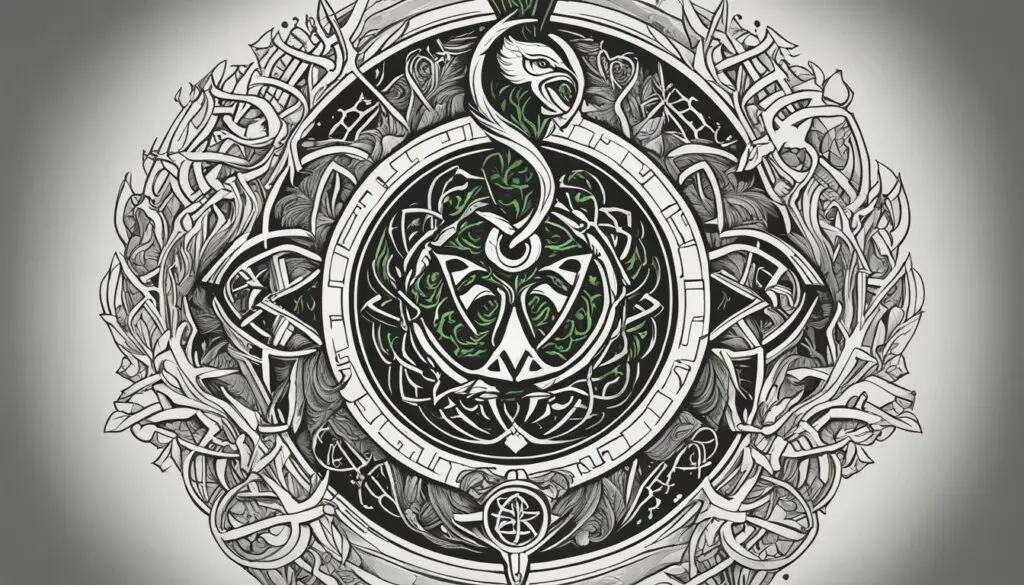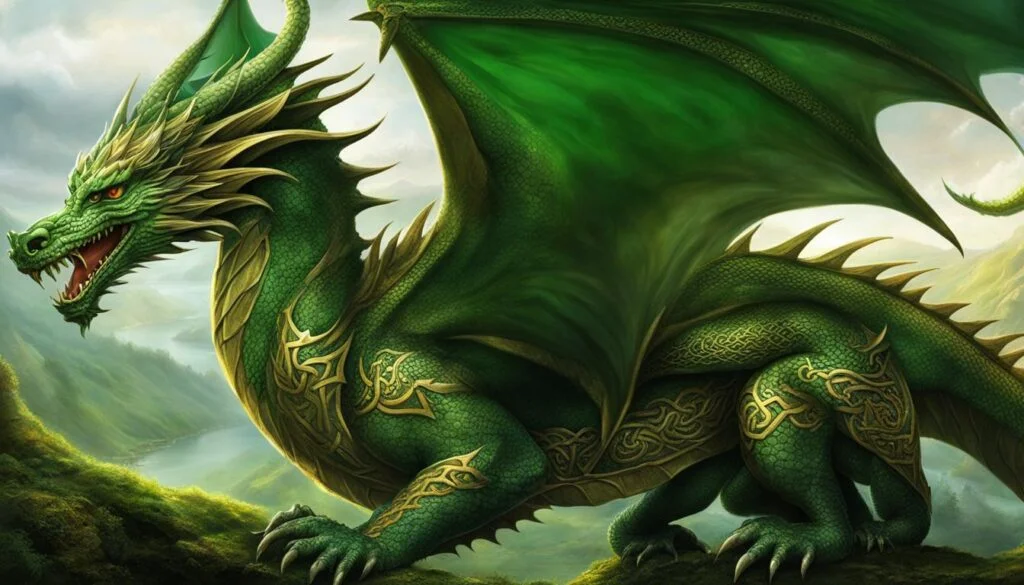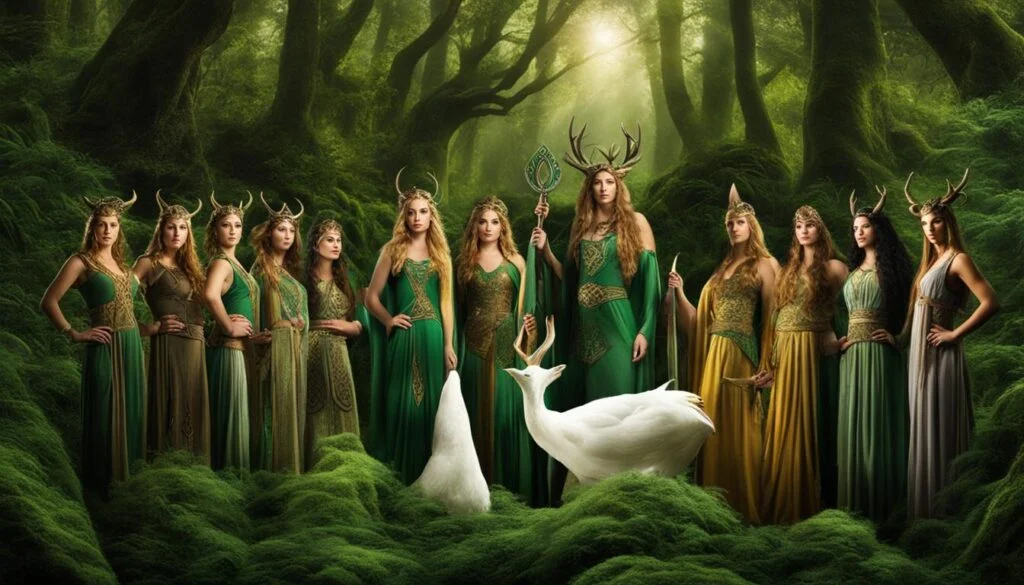In Irish mythology, the Dagda holds a position of great significance as the chief god of the Tuatha Dé Danann. He is a powerful deity associated with fertility, agriculture, wisdom, and magic. The Dagda is often depicted as a large bearded man or giant, wielding various formidable weapons and artifacts like a club, a cauldron, and a harp.
As a central figure in Irish folklore, the Dagda plays a prominent role in many myths and legends, leaving behind a rich tapestry of stories that contribute to our understanding of ancient Celtic culture. His representation, symbol, and the importance attributed to him in Irish mythology are legendary.
Key Takeaways:
- The Dagda is the chief god of the Tuatha Dé Danann in Irish mythology.
- He is associated with fertility, agriculture, wisdom, and magic.
- The Dagda wields powerful weapons and artifacts, such as a club, a cauldron, and a harp.
- His myths and legends contribute to the rich folklore of Ireland.
- The Dagda holds great significance in ancient Celtic culture and remains an important symbol in Irish mythology.
The Name and Etymology of the Dagda
In Irish mythology, the Dagda is a prominent figure revered as the chief god of the Tuatha Dé Danann. The name “Dagda” holds deep meaning and is believed to derive from Proto-Celtic roots, signifying “the good god” or “the great god.” The etymology of the Dagda’s name reflects his significance and divine nature within the mythological context.
The Dagda is known by various names and epithets that further exemplify different aspects of his character and abilities. One of his alternative names is Eochu Ollathair, which translates to “the horseman and father of all,” highlighting his role as a leader and progenitor. Another epithet is Ruad Rofhessa, meaning “the red one of great knowledge,” underscoring his wisdom and vast understanding of the world. Additionally, the Dagda is referred to as Dáire, connecting him to the concept of transformation and regeneration.
These diverse names and titles encapsulate the multifaceted nature of the Dagda, representing his role as a powerful deity associated with fertility, wisdom, and magic. Each epithet adds depth to his persona within Irish mythology and contributes to his enduring legacy.
The Attributes and Abilities of the Dagda
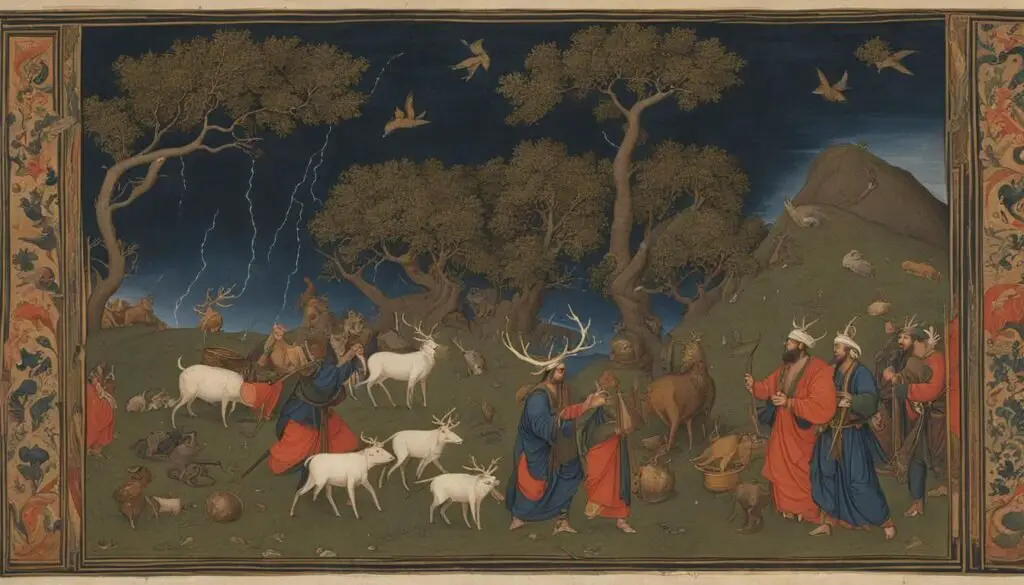
The Dagda, the chief god of the Tuatha Dé Danann, possesses a diverse range of powers and abilities. As a deity associated with life and death, he holds dominion over various aspects of nature and existence. His abilities extend to controlling the seasons, influencing weather patterns, and ensuring the fertility of the land for successful agriculture.
One of the notable features of the Dagda is his possession of powerful artifacts. His cauldron, known as the “Cauldron of Plenty,” is said to never run empty, providing an endless supply of nourishment and sustenance. This cauldron symbolizes abundance and represents the Dagda’s role as a provider.
Another remarkable artifact in the Dagda’s possession is his mighty club, often referred to as the “Club of Life and Death.” This club has the power to both kill and revive, making it a formidable weapon that can determine the fate of individuals and even entire armies. It represents the Dagda’s authority over life and his role as a guardian of the balance between existence and mortality.
The Dagda is also associated with a harp of immense significance. Known as the “Harp of Dagda,” this instrument possesses the ability to control emotions and change the seasons. When played, it has the power to soothe and inspire or evoke sorrow and joy. The harp serves as a reminder of the Dagda’s mastery of music and his influence over the emotional landscape of the world.
Besides his extraordinary artifacts, the Dagda is revered for his wisdom and knowledge. He is regarded as a skilled druid, possessing deep understanding and insight into the workings of the universe. With his extensive wisdom, the Dagda guides and shapes the events of Irish mythology, playing a crucial role in the intricate tapestry of gods, heroes, and legends.
The Dagda’s Abilities and Artifacts:
- Cauldron of Plenty: A symbol of abundance, this cauldron never runs empty, providing an endless supply of nourishment.
- Club of Life and Death: With the power to kill and revive, this mighty club allows the Dagda to shape the fate of individuals and armies.
- Harp of Dagda: This harp can control emotions and change the seasons, showcasing the Dagda’s mastery of music and influence over the world’s emotional landscape.
The Appearance and Dwelling of the Dagda
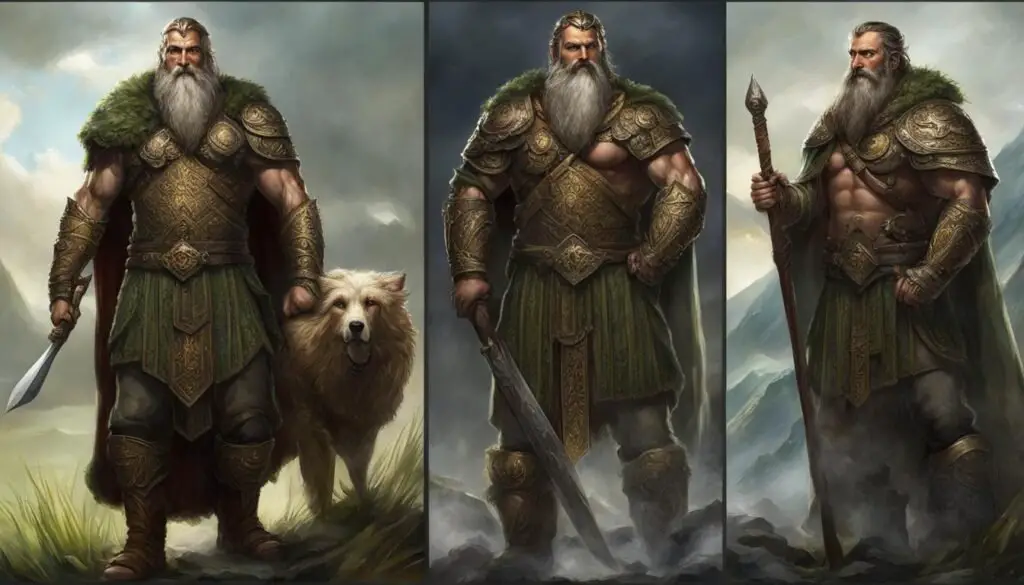
The Dagda, the chief god of the Tuatha Dé Danann in Irish mythology, is often depicted as a giant man with a long, unruly beard. His appearance is both fierce and comical, reflecting his multifaceted nature. He is commonly portrayed wearing a woolen cloak, adding to his imposing presence.
The Dagda’s dwelling is believed to be in Brú na Bóinne, a series of ancient mounds located in County Meath, Ireland. These mounds are associated with the regeneration of the sun and the cycles of time, aligning with the Dagda’s role as a deity of fertility and the seasons. Within this sacred landscape, the Dagda embodies the power and essence of Irish mythology.
The Family of the Dagda
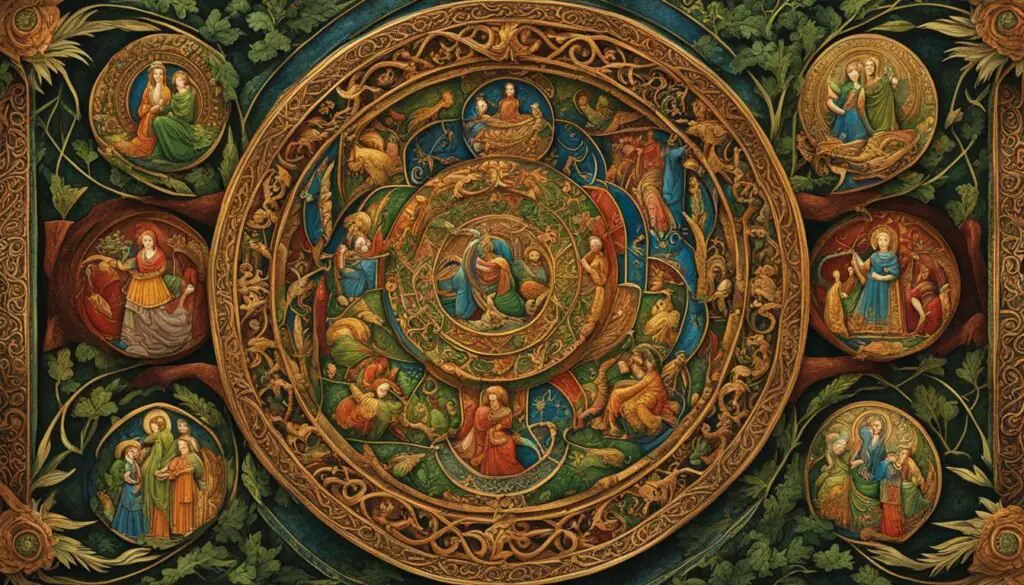
The Dagda, chief god in Irish mythology, is known for his extensive family. He has multiple romantic partners and numerous children, making him a prominent figure in the mythical realm.
One of the Dagda’s significant relationships is with the Morrígan, the goddess of war and fate. As his wife or lover, she holds a prominent role in his family. Additionally, the Dagda is associated with Boann, the river goddess, further expanding his divine connections.
The Dagda’s children are equally noteworthy. Among his many offspring, some prominently mentioned include Aengus, Brigit, and Midir. These children play significant roles in Irish mythology and contribute to the rich tapestry of ancient folklore.
In various mythological accounts, the parentage of the Dagda differs, but he is often associated with Elatha and Danu. These associations highlight the interconnections within Irish mythology and the complexity of the Dagda’s divine lineage. Furthermore, the Dagda is also related to several brothers, including Nuada and Ogma, reinforcing his familial ties.
The Morrígan and Boann: Divine Partners
- The Morrígan: Goddess of war and fate
- Boann: River goddess
Children of the Dagda
- Aengus: Prominent figure in Irish mythology
- Brigit: Associated with wisdom, poetry, and healing
- Midir: Figure in love and courtship tales
The Dagda’s Varied Parentage
- Elatha: Potential father figure
- Danu: Possible mother figure
The Mythology and Legends of the Dagda
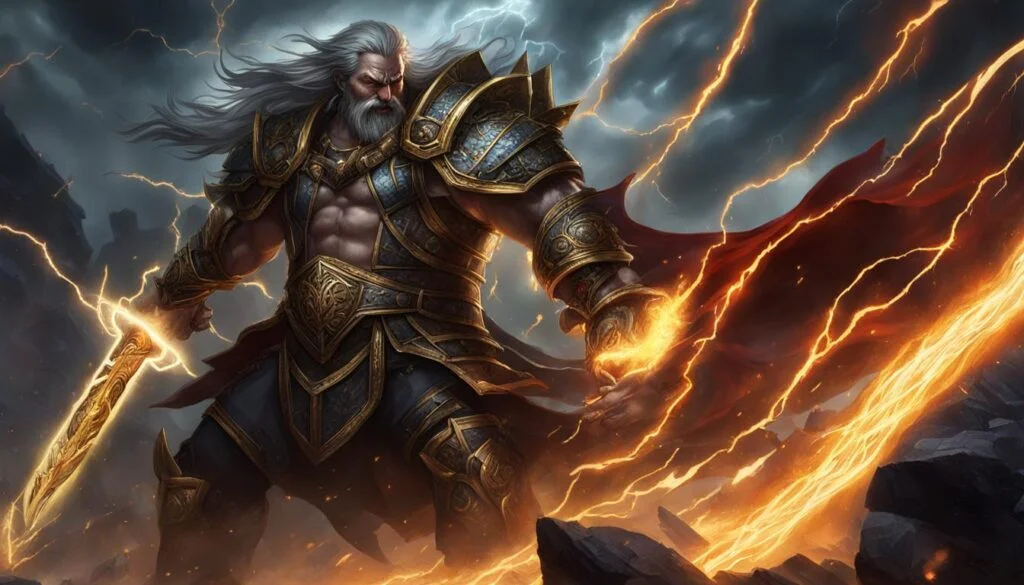
The Dagda, a prominent figure in Irish mythology, is woven into numerous captivating myths and legends that showcase his pivotal role in the ancient tales. From epic battles to encounters with mythical beings, the Dagda’s stories continue to captivate audiences to this day.
Battles and Victories
One of the defining moments in the Dagda’s mythology is his involvement in the Second Battle of Mag Tuired. In this momentous clash, the Dagda played a crucial role in leading the Tuatha Dé Danann to victory over their formidable foes, the Fomorians. Through his strategic prowess and immense power, the Dagda emerged as a revered and influential figure in Irish folklore.
Association with Samhain
The Dagda is intimately tied to the ancient festival of Samhain, which marked the end of the harvest season and the beginning of winter in Celtic traditions. As a god of fertility and agriculture, the Dagda’s presence during Samhain held immense significance. This festival is believed to have served as a time for commemoration and connection with the spirit world, where the Dagda’s wisdom and protection were invoked.
Encounters with Mythical Beings
Throughout his mythological journey, the Dagda encountered and interacted with various legendary figures. One such figure is the Morrígan, the goddess of war and fate, with whom the Dagda shared a romantic relationship. These encounters with powerful beings showcase the Dagda’s larger-than-life persona and his importance within the intricate web of Irish mythology.
As seen through these captivating mythology and legends, the Dagda’s influence in Irish folklore is undeniable. Whether leading his people to victory, embodying the essence of Samhain, or engaging with other mythical beings, the Dagda continues to inspire and fascinate audiences with his immense power and profound presence.
The Dagda in Comparison to Other Gods
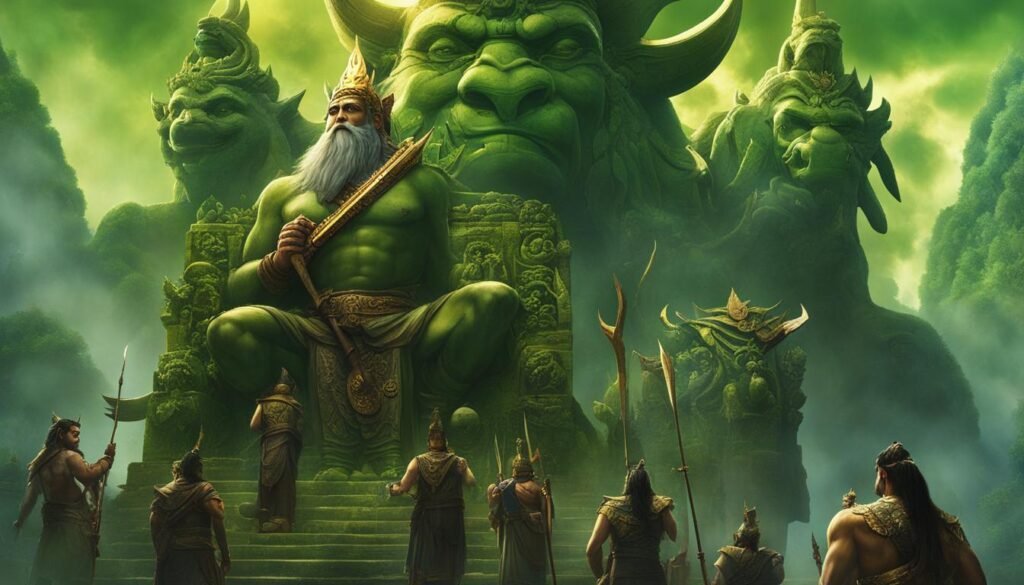
The Dagda, a prominent figure in Irish mythology, has been compared to various gods from other mythologies. These comparisons shed light on the cultural exchange and common themes across different mythologies. Let’s explore some of the notable comparisons:
- Dagda and Odin: In Germanic mythology, Odin holds a similar position as the chief god and father-figure. Both Dagda and Odin are associated with wisdom, magic, and leadership. They possess powerful artifacts, such as Odin’s spear Gungnir and the Dagda’s club, and are revered for their deep knowledge.
- Dagda and Sucellos: Sucellos, a Gaulish god, shares many similarities with the Dagda. Both gods are associated with fertility, agriculture, and the natural world. They are often depicted as powerful, bearded figures with symbols of abundance, Sucellos with his hammer and the Dagda with his cauldron.
- Dagda and Dis Pater: In Roman mythology, Dis Pater is the god of the underworld and riches. Some scholars draw parallels between Dis Pater and the Dagda due to their associations with death, the afterlife, and abundance. Both gods hold significant roles in their respective mythologies, representing important aspects of the divine.
These comparisons highlight the interconnectedness and cultural exchange that existed between different mythologies. While each god has unique characteristics and attributes, the similarities between the Dagda, Odin, Sucellos, and Dis Pater emphasize the universal themes and archetypes present in mythological traditions.
Continue reading to explore the cultural influence and significance of the Dagda in subsequent sections of this article.
The Dagda in Cultural Influence
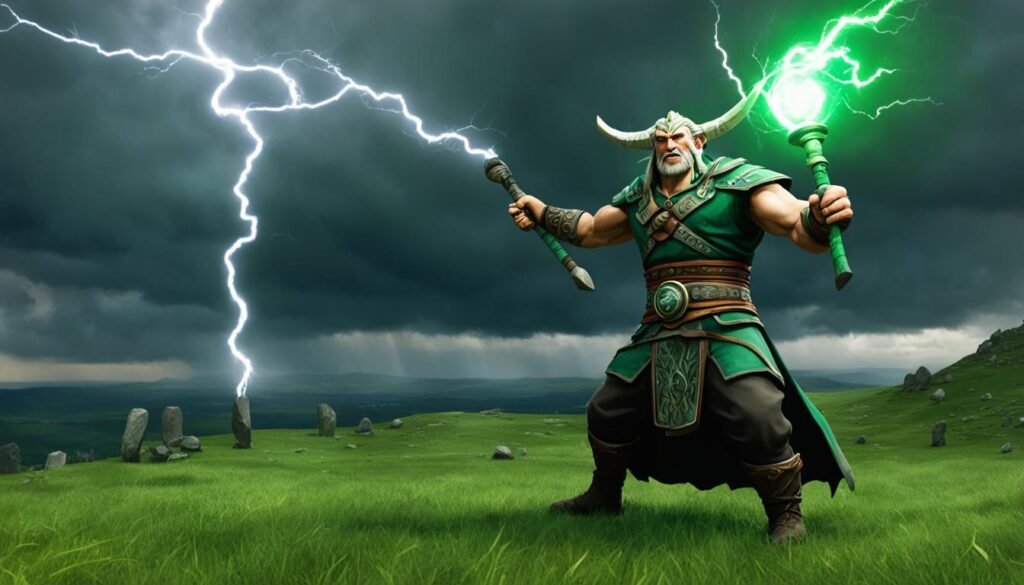
The Dagda, a prominent figure in Irish mythology, has left a lasting impact on popular culture. His character and attributes have made appearances in various forms of media, including literature, games, and comics.
Literature
The Dagda’s influence can be found in a range of literary works. He has been featured in popular fantasy role-playing games such as Dungeons & Dragons and Scion, where players can explore his rich mythology and engage with his powerful presence. His inclusion in these narratives adds depth and intrigue to the storytelling experience.
Games
With his larger-than-life persona and mystical abilities, the Dagda has also found a place in the realm of gaming. Players can encounter his character in games like Dungeons & Dragons and Scion, immersing themselves in the world of Irish mythology and experiencing the wonder and magic associated with the Dagda.
Comics
Marvel Comics and Hellboy are just two examples of comic book series that have incorporated the Dagda into their stories. His portrayal in these comics highlights his cultural significance and showcases his unique attributes and abilities to a wider audience. The Dagda’s presence in the comic book medium brings a touch of Irish mythology and folklore to the world of superheroes and fantastical adventures.
The Significance of the Dagda in Irish Mythology
The Dagda holds great significance in Irish mythology as the chief god of the Tuatha Dé Danann and a symbol of fertility, wisdom, and power. His role as a father-figure, leader, and druid reflects the values and beliefs of ancient Celtic culture. The Dagda’s stories and legends contribute to the understanding of Irish folklore and the cultural heritage of Ireland.
Conclusion
The Dagda, as the chief god of the Tuatha Dé Danann, holds a central position in Irish mythology. Representing various aspects of power, wisdom, and magic, he has become an icon of Irish culture and folklore. The legends and myths surrounding the Dagda continue to captivate and inspire people to explore the rich tapestry of Irish storytelling.
With his influential role as a father-figure, leader, and druid, the Dagda symbolizes the values and beliefs of ancient Celtic society. From his divine artifacts, such as the never-empty cauldron and the emotion-controlling harp, to his association with fertility, agriculture, and time, the Dagda represents the interconnectedness of nature and humanity.
As we delve into the enchanting world of Irish mythology, the Dagda’s significance becomes even more evident. His stories shed light on the cultural heritage of Ireland and contribute to our understanding of the ancient Celtic traditions that have shaped the country’s history. The Dagda’s legacy lives on as we continue to celebrate and honor this remarkable deity.
FAQ
Who is Dagda in Irish mythology, and what does he represent?
Dagda is the chief god in Irish mythology and represents fertility, agriculture, wisdom, and magic. He is associated with the Tuatha Dé Danann and is known for his powerful weapons and artifacts.
What are some other names or epithets of the Dagda?
The Dagda is also known as Eochaid Ollathair, Ruad Rofhessa, and Dáire. These names reflect different aspects of his character and abilities.
What powers and abilities does the Dagda possess?
The Dagda has dominion over life and death, seasons, weather, fertility, agriculture, and time. He possesses powerful artifacts like a cauldron, a club, and a harp. He is also a skilled druid and possesses great wisdom and knowledge.
How is the Dagda depicted in appearance and where does he dwell?
The Dagda is often depicted as a giant man with a long, unruly beard and wearing a woolen cloak. He is said to dwell in Brú na Bóinne, ancient mounds in County Meath, Ireland, associated with the regeneration of the sun and the cycles of time.
Who are the family members of the Dagda?
The Dagda’s wife or lover is the Morrígan, the goddess of war and fate. He is also associated with Boann, the river goddess. Some of his prominent children include Aengus, Brigit, and Midir. He is often associated with Elatha and Danu as his parents and has several brothers, including Nuada and Ogma.
What roles does the Dagda play in Irish mythology?
The Dagda is involved in important battles like the Second Battle of Mag Tuired, where he plays a crucial part in the victory of the Tuatha Dé Danann. He is associated with the festival of Samhain and has encounters with other mythical figures like the Morrígan and Boann.
Are there any gods from other mythologies that the Dagda is compared to?
Yes, the Dagda shares similarities with Odin from Germanic mythology, Sucellos from Gaulish mythology, and Dis Pater from Roman mythology, highlighting the cultural exchange and common themes across different mythologies.
How has the Dagda influenced popular culture?
The Dagda has been featured in literature and has appeared in works like Dungeons & Dragons, Scion, Marvel Comics, Hellboy, and more. His character and attributes are often referenced or adapted in modern storytelling and media.
What significance does the Dagda hold in Irish mythology?
The Dagda is the chief god of the Tuatha Dé Danann and symbolizes fertility, wisdom, and power. His role as a father-figure, leader, and druid reflects the values and beliefs of ancient Celtic culture. His stories and legends contribute to the understanding of Irish folklore and the cultural heritage of Ireland.


